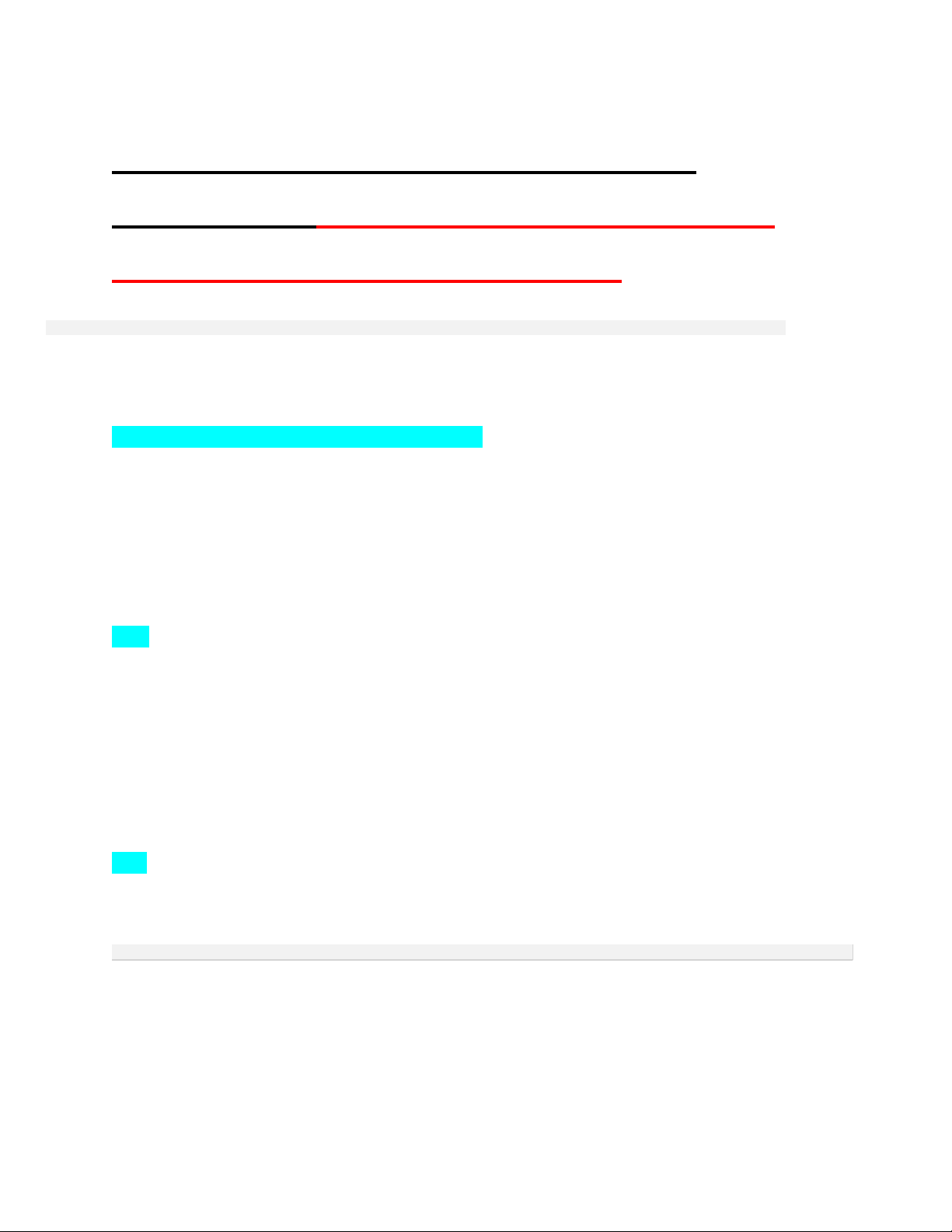
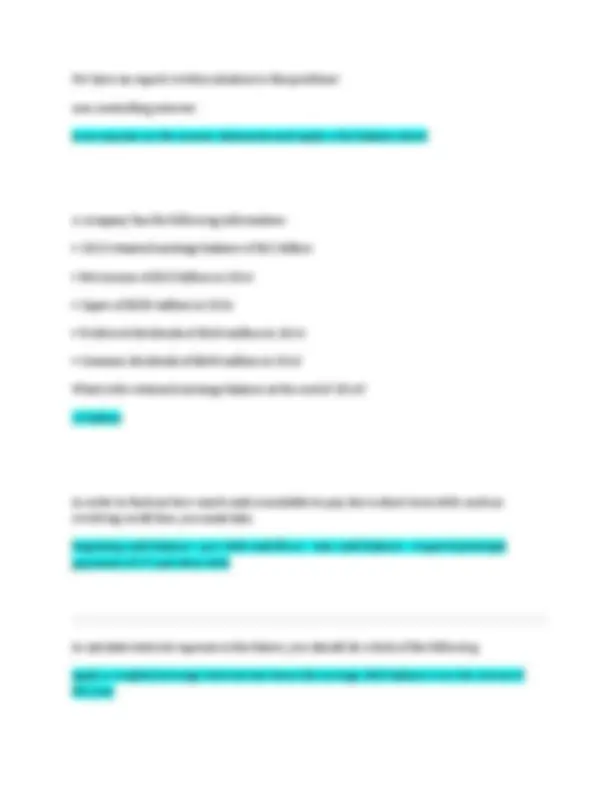
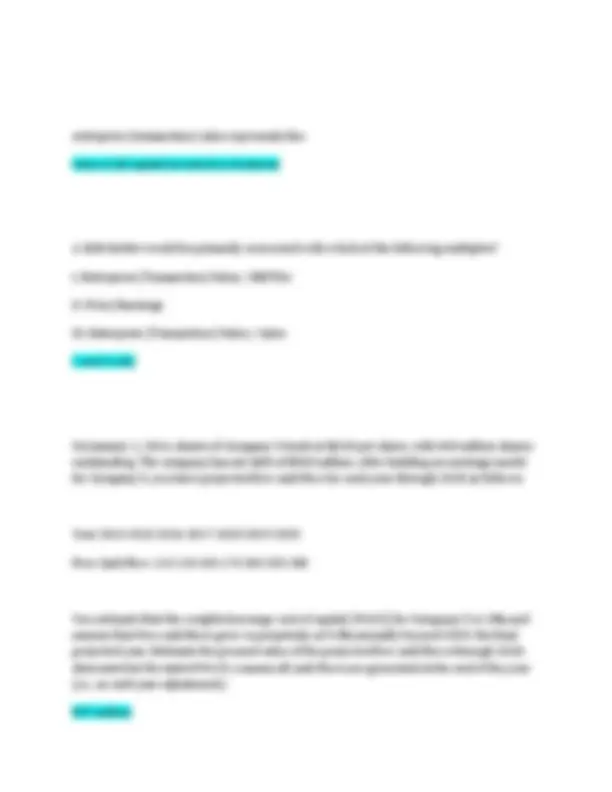
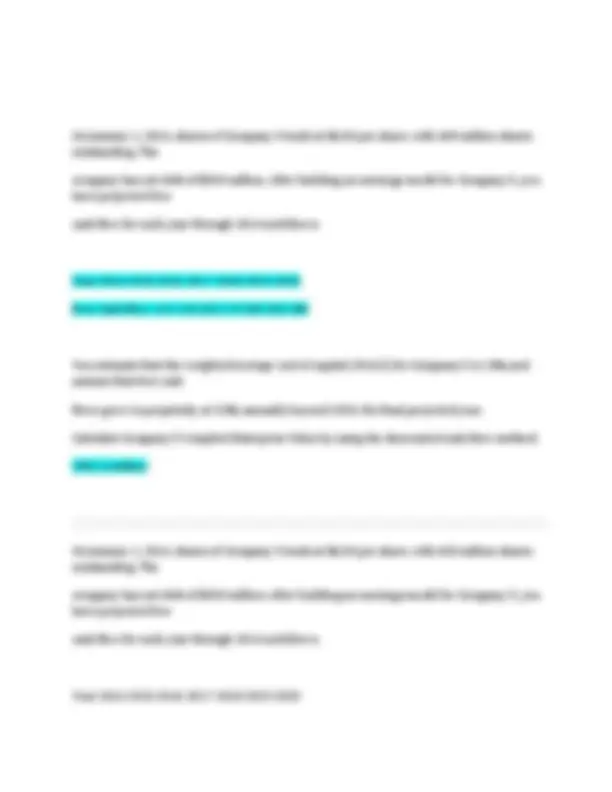
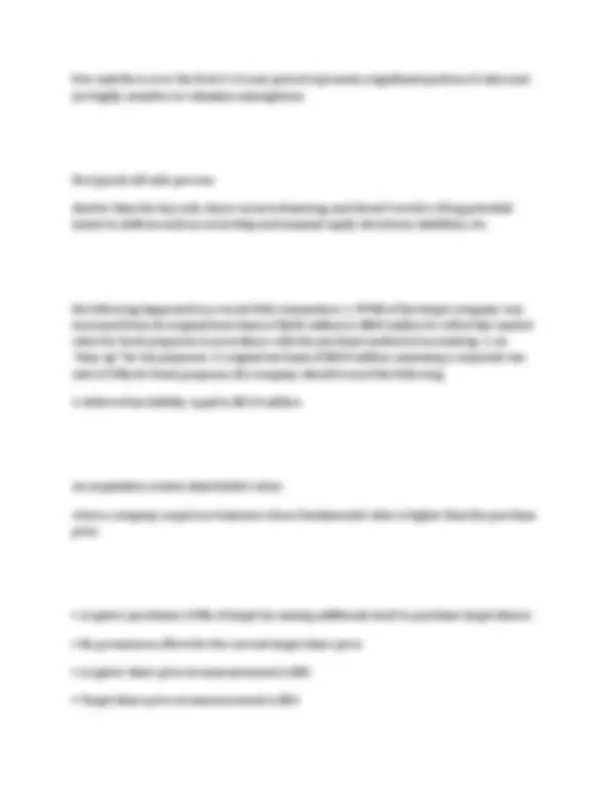
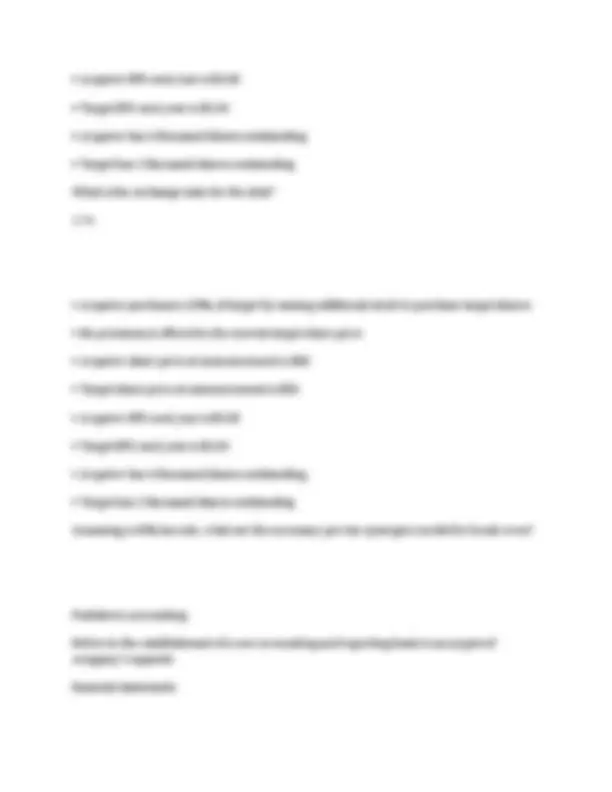
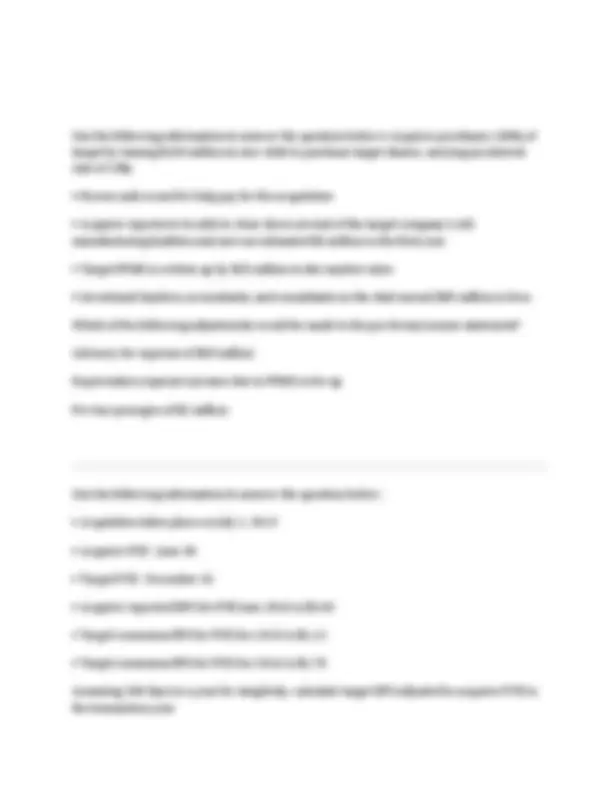
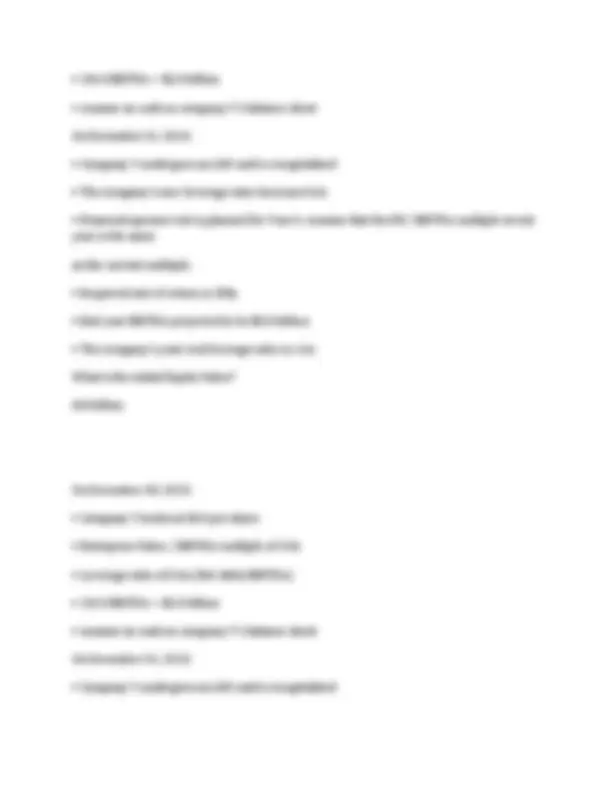
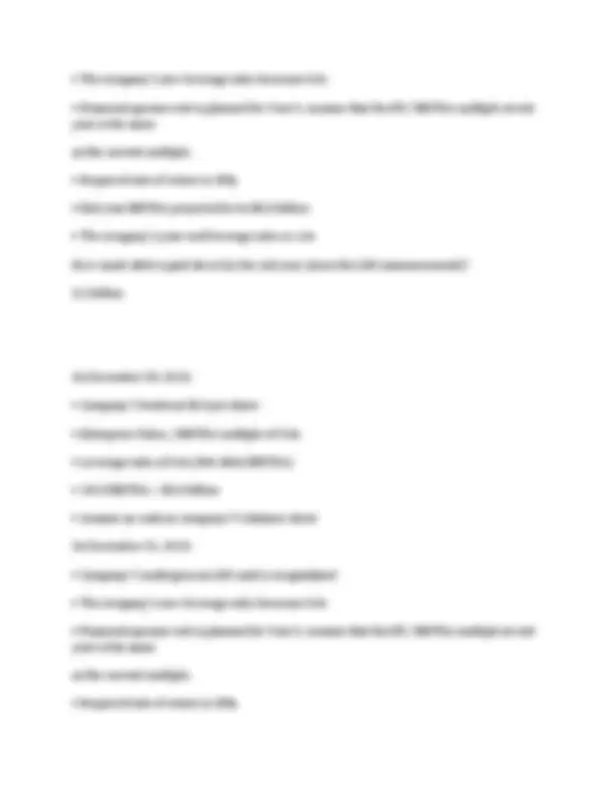



Study with the several resources on Docsity

Earn points by helping other students or get them with a premium plan


Prepare for your exams
Study with the several resources on Docsity

Earn points to download
Earn points by helping other students or get them with a premium plan
Community
Ask the community for help and clear up your study doubts
Discover the best universities in your country according to Docsity users
Free resources
Download our free guides on studying techniques, anxiety management strategies, and thesis advice from Docsity tutors
A series of questions and answers related to financial modeling and valuation, covering topics such as depreciation expense, operating margin, days sales outstanding, inventory days, share repurchase, retained earnings, enterprise value, discounted cash flow (dcf) analysis, mergers and acquisitions (m&a), and leveraged buyouts (lbos). It provides insights into key financial concepts and calculations used in corporate finance.
Typology: Exams
1 / 17

This page cannot be seen from the preview
Don't miss anything!










Depreciation Expense found in the SG&A line of the income statement for a manufacturing firm would most likely be attributable to which of the following computers used by the accounting department If a company has projected revenues of $10 billion, a gross profit margin of 65%, and projected SG&A expenses of $2billion, what is the company's operating (EBIT) margin? 45% A company has the following information, 1. 2014 revenues of $5 billion,2013 Accounts receivable of $400 million, 2014 accounts receivable of $600 million, what are the days sales outstanding
A company has the following information:
enterprise (transaction) value represents the: value of all capital invested in a business A debt holder would be primarily concerned with which of the following multiples? I. Enterprise (Transaction) Value / EBITDA II. Price/Earnings III. Enterprise (Transaction) Value / Sales 1 and 3 only On January 1, 2014, shares of Company X trade at $6.50 per share, with 400 million shares outstanding. The company has net debt of $300 million. After building an earnings model for Company X, you have projected free cash flow for each year through 2020 as follows: Year 2014 2015 2016 2017 2018 2019 2020 Free Cash Flow 110 120 150 170 200 250 280 You estimate that the weighted average cost of capital (WACC) for Company X is 10% and assume that free cash flows grow in perpetuity at 3.0% annually beyond 2020, the final projected year. Estimate the present value of the projected free cash flows through 2020, discounted at the stated WACC. Assume all cash flows are generated at the end of the year (i.e., no mid-year adjustment): 837 million
On January 1, 2014, shares of Company X trade at $6.50 per share, with 400 million shares outstanding. The company has net debt of $300 million. After building an earnings model for Company X, you have projected free cash flow for each year through 2014 as follows: Year 2014 2015 2016 2017 2018 2019 2020 Free Cash Flow 110 120 150 170 200 250 280 You estimate that the weighted average cost of capital (WACC) for Company X is 10% and assume that free cash flows grow in perpetuity at 3.0% annually beyond 2020, the final projected year. Calculate Company X's implied Enterprise Value by using the discounted cash flow method: 2951.2 million On January 1, 2014, shares of Company X trade at $6.50 per share, with 400 million shares outstanding. The company has net debt of $300 million. After building an earnings model for Company X, you have projected free cash flow for each year through 2014 as follows: Year 2014 2015 2016 2017 2018 2019 2020
a decrease of 15 million the final component of an earnings projection model is calculating interest expense. the calculation may create a circular reference because interest expense affects net income, which affects FCF, which affects the amount of debt a company pays down, which, in turn affects the interest expense, hence the circular reference a 10-q financial filing has all of the following characteristics except issued four times a year. the terminal value of a business that grows indefinitely is calculated as follows cash flow from period "t+1" divided by (discount rate-growth rate) the two-stage DCF model is: where stage 1 is an explicit projection of free cash flows (generally for 5-10 years), and stage 2 is a lump-sum estimate of the cash flows beyond the explicit forecast period disadvantages of a DCF do not include
free cash flows over the first 5-10 year period represent a significant portion of value and are highly sensitive to valuation assumptions the typical sell-side process shorter than the buy side, buyer secures financing, and doesn't involve id'ing potential issues to address such as ownership and unusual equity structures, liabilities, etc. the following happened in a recent M&A transaction: 1. PP&E of the target company was increased from its original book basis of $600 million to $800 million to reflect fair market value for book purposes in accordance with the purchase method of accounting. 2. no "step-up" for tax purposes. 3. original tax basis of $650 million. assuming a corporate tax rate of 35% for book purposes, the company should record the following A deferred tax liability equal to $52.5 million An acquisition creates shareholder value: when a company acquires a business whose fundamental value is higher than the purchase price
Use the following information to answer the question below:• Acquirer purchases 100% of target by issuing $100 million in new debt to purchase target shares, carrying an interest rate of 10%
(FYE June 2014) $1. A 338(h)(10) election: Requires that both buyer and seller must jointly elect to have the IRS deem the acquisition an asset sale for tax purposes A good LBO candidate has which of the following characteristics? Little to no existing leverage, steady cash flows and little investment in business through capex and working capital Which of the following is NOT a disadvantage of performing an LBO analysis? Stand-alone LBO may overestimate strategic sale value by ignoring synergies with acquirer While equity contribution went as low as the single digits in the 1980's, the current split between equity and debt in an LBO deal is best characterized as: Equity - 35%; Debt 65%
I. Enterprise (Transaction) Value / EBITDA II. Price/Earnings III. Enterprise (Transaction) Value / Sales one and three only Company A shares are currently trading at $20 per share. A survey of Wall Street analysts reveals that EPS expectations for Company A for the full year 2014 are $1.50 per share. Company A has 200 million diluted shares outstanding. Company A's major competitors are trading at an average share price / 2014 Expected EPS of 15.0x. Using the comparable company analysis valuation method, Company A shares are: 2.5 per share undervalued When looking to do a transaction comp analysis, some of the merger-related filings that should be looked at include each of the following except: Form s- 1 when determining value for a company based on transaction rather than trading comps, one of the key differences that will affect the value is premium paid for control of the business Garth's Micro Brewery, whose shares are currently trading at $40 per share, is considering acquiring Wayne's
Beer Bottling Co. You have compiled a group of comparable transactions within the beer bottling space and have calculated that since 2014, acquisitions similar (or comparable!) to the one Garth's is currently considering have had transaction values (offer value of target plus any target debt, net of cash) that are, on average, 8.0x target's EBITDA.